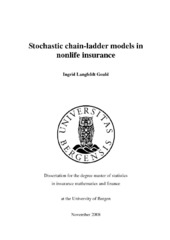Stochastic chain-ladder models in nonlife insurance
Master thesis
Permanent lenke
https://hdl.handle.net/1956/3370Utgivelsesdato
2008Metadata
Vis full innførselSamlinger
Sammendrag
This thesis examines the stochastic models which reproduce chain-ladder estimates used in reserve estimation for nonlife insurance. The chain-ladder method provides no information regarding the variability of the outcome, thereby adding uncertainty to future claim estimations. Prediction errors can be found using a variety of stochastic chain-ladder models, but the different models are based on different assumptions. The relationship between some of these models was explored, and it was demonstrated how the models are defined for a runoff triangle of insurance claims. Two of these models, Mack’s model and the normal approximation to the negative binomial model, were applied to a data set consisting of auto liability insurance claims. This was done in order to find the prediction error of their chain ladder estimates, as well as verify their ability to handle negative values. The two models used in the analysis were found to produce nearly identical prediction errors, and both were able to handle negative insurance claims, which were present in the data set. A number of similarities were found between the models, to the degree that the normal approximation to the negative binomial model should be considered as underlying Mack’s model. However, since it is based on a generalized linear model, the normal approximation to the negative binomial model offers greater flexibility in applied calculations than Mack’s model.
Utgiver
The University of BergenOpphavsrett
The authorCopyright the author. All rights reserved
